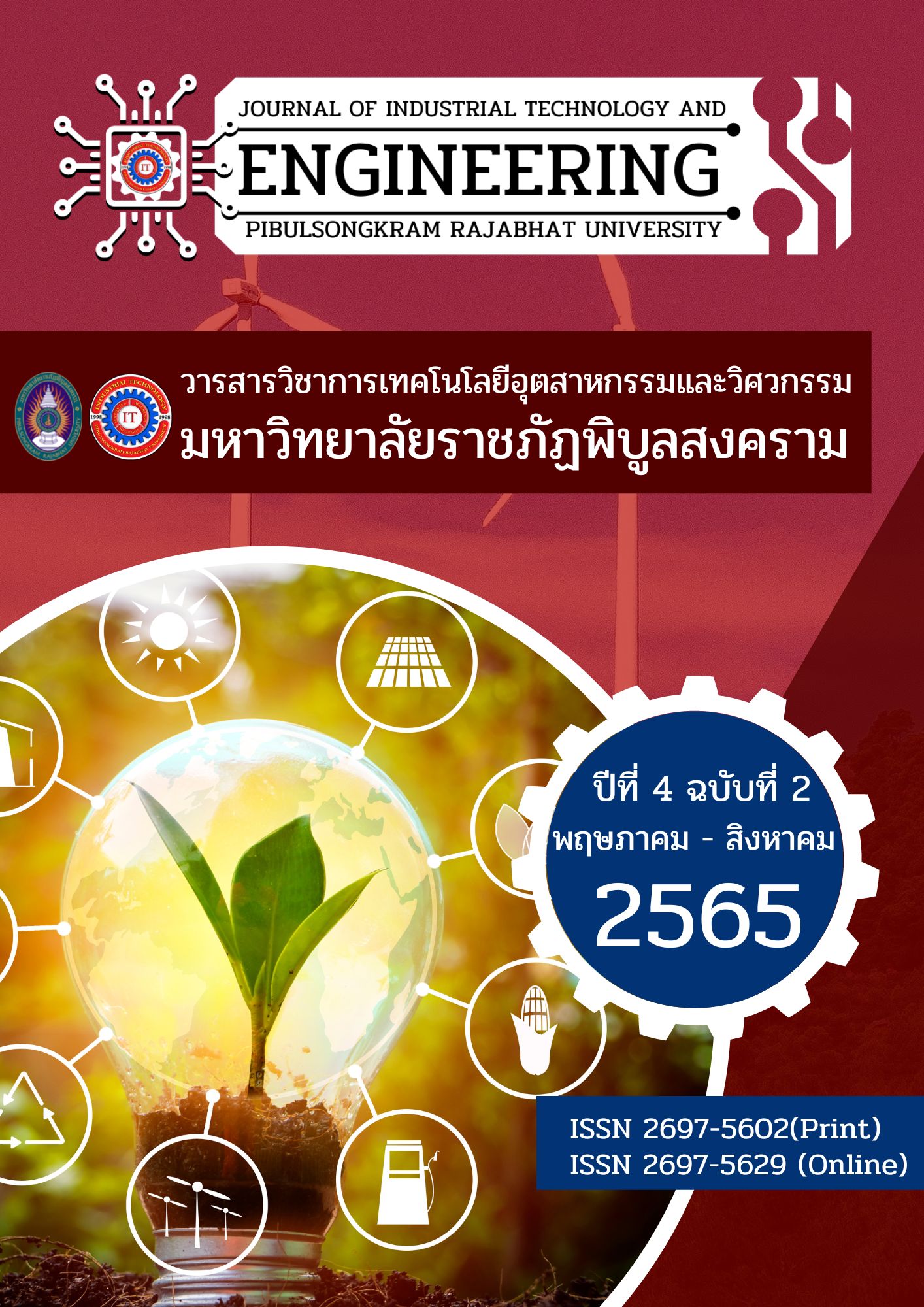การกำจัดก๊าซคาร์บอนมอนอกไซด์ในเชื้อเพลิงไฮโดรเจนด้วยโลหะออกไซด์ผสมคอปเปอร์ ซีเรียมและ อลูมิเนียม ที่เตรียมด้วยวิธีโซลเจล และโซลเจลขั้นตอนเดียว
คำสำคัญ:
โซลเจลขั้นตอนเดียว, อลูมิเนียมออกไซด์, คอปเปอร์ออกไซด์, ซีเรียมออกไซด์, ปฏิกิริยาการเลือกเกิดคาร์บอนมอนอกไซด์ออกซิเดชันบทคัดย่อ
การกำจัดก๊าซคาร์บอนมอนอกไซด์ปริมาณน้อยออกจากรีฟอร์มก๊าซ ก่อนนำไปใช้กับเซลเชื้อเพลิงแบบเยื่อเมมเบรนแลกเปลี่ยนโปรตอนเป็นเรื่องสำคัญที่ต้องปฏิบัติ เพื่อเพิ่มอายุการใช้งานให้กับเซลเชื้อเพลิง เนื่องจากก๊าซคาร์บอนมอนอกไซด์มีความเป็นพิษต่อแพลทินัมที่ขั้วแอโนดของเซลเชื้อเพลิง ในงานวิจัยนี้ศึกษาความสามารถในการเร่งปฏิกิริยาของโลหะออกไซด์ผสมคอปเปอร์ ซีเรียม และอลูมิเนียม เพื่อกำจัดก๊าซคาร์บอนมอนอกไซด์ในสภาวะที่มีก๊าซไฮโดรเจนในปริมาณมาก ด้วยปฏิกิริยาการเลือกเกิดการเผาไหม้ก๊าซคาร์บอนมอนอกไซด์ โดยศึกษาผลกระทบวิธีการเตรียมตัวเร่งปฏิกิริยาต่อโครงสร้าง และความสามารถในการเร่งปฏิกิริยา ตัวเร่งปฏิกิริยาถูกเตรียมด้วยวิธีโซลเจล และวิธีโซลเจลขั้นตอนเดียว และถูกนำไปวิเคราะห์คุณสมบัติเฉพาะได้แก่ โครงสร้างและขนาดผลึกเฉลี่ยด้วยวิธีเอ็กซ์เรย์ดิฟแฟรคชัน พื้นที่ผิวจำเพาะด้วยวิธีการดูดซับ-คายก๊าซไนโตรเจน ในการทดสอบความสามารถในการเร่งปฏิกิริยาพบว่าในสภาวะที่ไม่มีก๊าซไฮโดรเจน ตัวเร่งปฏิกิริยาทั้งสองให้ผลการเร่งปฏิกิริยาที่ใกล้เคียงกัน และเมื่อกระแสป้อนมีก๊าซไฮโดรเจนในปริมาณร้อยละ 50 โดยปริมาตร ตัวเร่งปฏิกิริยาที่เตรียมด้วยวิธีโซลเจล ให้ผลการเร่งปฏิกิริยาที่ดีกว่าทั้งในค่าร้อยละการเปลี่ยนแปลงก๊าซคาร์บอนมอนอกไซด์ และค่าร้อยละการเลือกเกิดคาร์บอนมอนอกไซด์ออกซิเดชัน โดยก๊าซคาร์บอนมอนอกไซด์ถูกกำจัดอย่างสมบูรณ์ที่อุณหภูมิ 180 องศาเซลเซียส ที่ค่าร้อยละการเลือกเกิดคาร์บอนมอนอกไซด์ออกซิเดชัน เท่ากับ 65.0 นอกจากนี้พบว่าก๊าซคาร์บอนไดออกไซด์และน้ำส่งผลกระทบความสามารถในการเร่งปฏิกิริยา โดยทำให้การเร่งปฏิกิริยาเกิดช้าลง
เอกสารอ้างอิง
Bae, C.M., Ko, J.B. & Kim, D.H. (2005). Selective catalytic oxidation of carbon
monoxide with carbon dioxide, water vapor and excess hydrogen on
CuO-CeO2 mixed oxide catalyst. Catalysis communication, 6, 507-511.
Doi: https://doi.org/10.1016/j.catcom.2005.04.017
Brinker, C.J. & Scherer, G.W. (1990). Sol-Gel Science: The Physics and Chemistry of Sol–Gel Processing. New York: ACADEMIC PRESS, INC.
Chen, Y.Z., Liaw, B.J., Wang, J.M. & Huang, C.T. (2008). Selective removal of CO from hydrogen rich stream over CuO/CexSn1-xO2–Al2O3 catalysts. International Journal of hydrogen energy, 33, 2389-2399.
Doi: https://doi.org/10.1016/j.ijhydene.2008.02.056
Cortés, A.G., Márquez, Y., Alatorre, J.A. & Díaz, G. (2008). Selective CO oxidation in excess of H2 over high surface area CuO/CeO2 catalysts. Catalysis Today, 133-135, 734-740. Doi: https://doi.org/10.1016/j.cattod.2007.12.083
Ebrahimi, P., Kumar, A. & Khraisheh, M. (2020). A review of recent advances in water-gas shift catalysis for hydrogen production. Emergent Materials, 3, 881–917.
Doi: https://doi.org/10.1007/s42247-020-00116-y
Esposito, S. (2019). “Traditional” sol-gel chemistry as a powerful tool for the preparation of supported metal and metal oxide catalysts. Materials, 12, 668. Doi: https://doi.org/10.3390/ma12040668
Gu, C., Liu, R., Wang, C., Sun, Y., & Zhang, S. (2020). Effect of aluminum on microstructure and high-temperature oxidation resistance of austenitic heat-resistant steel. Metals, 10(2), 176. Doi: https://doi.org/10.3390/met10020176
Hargreaves, J.S.J. (2016). Some considerations related to the use of the Scherrer equation in powder X-ray diffraction as applied to heterogeneous catalysts. Catalysis, Structure & Reactivity, 2, 33-37.
Huber, F., Venvik H., Ronning M., Walmsley J., & Holmen A. (2008). Preparation and characterization of nanocrystalline, high-surface area Cu Ce Zr mixed oxide catalysts from homogeneous coprecipitation. Chemical Engineering Journal 137, 686-702. Doi: https://doi.org/10.1016/j.cej.2007.07.025
Kakuta N., Morishima N., Kotobuki M., Iwase T., Mizushima T., Sato Y. & Matsuura S. (1997). Oxygen storage capacity (OSC) of aged Pt/CeO2/Al2O3 catalysts: roles of Pt and CeO2 supported on Al2O3. Applied Surface Science, 121-122, 408-412. Doi: https://doi.org/10.1016/S0169-4332(97)00346-2
Manasilp, A. & Gulari, E. (2002). Selective oxidation of Pt/alumina catalysts for fuel cell application, Applied Catalysis B: Environmental, 37, 17-25.
Doi: https://doi.org/10.1016/S0926-3373(01)00319-8
Qi Z., He C. & Kaufman A. (2020). Effect of CO in the anode fuel on the performance of PEM fuel cell cathode. Journal of Power Sources, 111, 239-247.
Doi: https://doi.org/10.1016/S0378-7753(02)00300-2
Moretti, E., Lenarda, M., Storaro, L., Talon, A., Montanari, T., Busca, G., Rodrıguez-Castellon, E., Jimenez-Lopez, A., Turco, M., Bagnasco, G. & Frattini, R. (2008). One-step synthesis of a structurally organized mesoporous CuO-CeO2-Al2O3 system for the preferential CO oxidation. Applied Catalysis A: General, 335, 46-55. Doi: https://doi.org/10.1016/j.apcata.2007.11.009
Polster, C.S., Nair, H. & Baertsch, C.D. (2006). Study of active sites and mechanism responsible for highly selective CO oxidation in Hydrogen rich atmospheres on a mixed Cu and Ce oxide catalyst. Journal of Catalysis, 266, 308-319.
Doi: https://doi.org/10.1016/j.jcat.2009.06.021
Qi Z., He C. & Kaufman A. (2020). Effect of CO in the anode fuel on the performance of PEM fuel cell cathode. Journal of Power Sources, 111, 239-247.
Doi: https://doi.org/10.1016/S0378-7753(02)00300-2
Ratnasamy, P., Srinivas, D., Satyanarayana, C.V.V., Manikandan, P., Kumaran, R.S.S., Sachin, M. & Shetti, V.N. (2004). Influence of the support on the preferential oxidation of CO in hydrogen-rich steam reformats over the CuO-CeO2-ZrO2 system. Journal of catalysis, 221, 454-465.
Doi: https://doi.org/10.1016/j.jcat.2003.09.006
Sarma, B.B., Plessow, P.N., Agostini, G., Concepción, P., Pfänder, N., Kang, L., Wang, F.R., Studt, F. & Prieto, G. (2020). Metal-specific reactivity in single-atom Catalysts: CO Oxidation on 4d and 5d Transition Metals Atomically Dispersed on MgO. Journal of American Chemical Society, 142(35), 14890-14902.
Doi: https://doi.org/10.1021/jacs.0c03627
Sreethawong, T., Suzuki, Y. & Yoshikawa, S. (2009). Platinum-loaded mesoporous titania by single-step sol–gel process with surfactant template: photocatalytic activity for hydrogen evolution. Comptes Rendus Chimie, 9, 307-314.
Doi: https://doi.org/10.1016/j.crci.2005.05.015
Thommes, M. (2010). Physical adsorption characterization of nanoporous materials, Chemie Ingenieur Technik, 82(7), 1059-1071.
Vazquez, A., Lopez, T., Gomez, R. & Bokhimi, X. (2001). Synthesis, characterization and catalytic properties of Pt/ CeO2–Al2O3 and Pt/La2O3–Al2O3 sol-gel derived catalysts. Journal of Molecular Catalysis A: Chemical, 167, 91-99.
Doi: https://doi.org/10.1016/S1381-1169(00)00495-7
Walton, K.S. & Snurr, R.Q. (2007). Applicability of the BET method for determining surface areas of microporous metal-organic frameworks. Journal of American Chemical Society, 129(27), 8552-8556.
Xu C., Li S., Zhang Y., Li Y., Zhou J., & Qin G. (2019). Synthesis of CuOx–CeO2 catalyst with high-density interfaces for selective oxidation of CO in H2-rich stream. International Journal of Hydrogen Energy, 44(8), 4156-4166.
Doi: https://doi.org/10.1016/j.ijhydene.2018.12.152
Zhang X., Su L., Kong Y., Ma D., Ran Y., Peng S., Wang L. & Wang Y. (2020). CeO2 nanoparticles modified by CuO nanoparticles for low-temperature CO oxidation with high catalytic activity. Journal of Physics and Chemistry of Solids, 147, 109651. Doi: https://doi.org/10.1016/j.jpcs.2020.109651
Zou, H., Dong, X. & Lin, W. (2005). CO Selective oxidation in hydrogen-rich gas over Cu-Ce Catalyst. Journal of natural gas chemistry, 14, 43-53.



